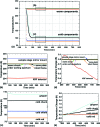The Bionanoprobe: hard X-ray fluorescence nanoprobe with cryogenic capabilities
- PMID: 24365918
- PMCID: PMC3874019
- DOI: 10.1107/S1600577513029676
The Bionanoprobe: hard X-ray fluorescence nanoprobe with cryogenic capabilities
Abstract
Hard X-ray fluorescence microscopy is one of the most sensitive techniques for performing trace elemental analysis of biological samples such as whole cells and tissues. Conventional sample preparation methods usually involve dehydration, which removes cellular water and may consequently cause structural collapse, or invasive processes such as embedding. Radiation-induced artifacts may also become an issue, particularly as the spatial resolution increases beyond the sub-micrometer scale. To allow imaging under hydrated conditions, close to the `natural state', as well as to reduce structural radiation damage, the Bionanoprobe (BNP) has been developed, a hard X-ray fluorescence nanoprobe with cryogenic sample environment and cryo transfer capabilities, dedicated to studying trace elements in frozen-hydrated biological systems. The BNP is installed at an undulator beamline at sector 21 of the Advanced Photon Source. It provides a spatial resolution of 30 nm for two-dimensional fluorescence imaging. In this first demonstration the instrument design and motion control principles are described, the instrument performance is quantified, and the first results obtained with the BNP on frozen-hydrated whole cells are reported.
Keywords: Bionanoprobe; cryogenic capabilities; hard X-ray fluorescence microscopy.
Figures









References
-
- Beetz, T. & Jacobsen, C. (2003). J. Synchrotron Rad. 10, 280–283. - PubMed
-
- Beveridge, T. J. (2005). J. Nucl. Radiochem. Sci. 6, 7–10.
-
- Bleuet, P., Cloetens, P., Gergaud, P., Mariolle, D., Chevalier, N., Tucoulou, R., Susini, J. & Chabli, A. (2009). Rev. Sci. Instrum. 80, 1–3. - PubMed
-
- Bohic, S., Cotte, M., Salomé, M., Fayard, B., Kuehbacher, M., Cloetens, P., Martinez-Criado, G., Tucoulou, R. & Susini, J. (2012). J. Struct. Biol. 177, 248–258. - PubMed
Publication types
MeSH terms
Substances
Grants and funding
LinkOut - more resources
Full Text Sources
Other Literature Sources

